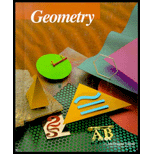
Concept explainers
Whether the reasoning process is deductive or inductive.
Answer to Problem 6CE
The given statement is inductive in nature.
Explanation of Solution
Given information:
The given theorem says that the sum of the measures of the
Calculation:
Reasoning is said to be deductive if conclusion depends upon the accepted statements. These statements may be definitions, postulate, previous theorems or corollaries. In deductive based reasoning conclusion must be true if hypothesis are true.
Reasoning is said to be inductive if conclusion is based on several previous observations. The conclusion based upon the inductive reasoning is probably true but not necessarily true.
The given theorem says that the sum of the measures of the angles of convex polygon with
The reasoning in the given theorem uses several previous observations. According to above definition if any conclusion is based on several past observations then it is called inductive in nature.
Hence the given statement is inductive in nature.
Chapter 3 Solutions
McDougal Littell Jurgensen Geometry: Student Edition Geometry
Additional Math Textbook Solutions
Algebra and Trigonometry (6th Edition)
Pre-Algebra Student Edition
Basic Business Statistics, Student Value Edition
Calculus for Business, Economics, Life Sciences, and Social Sciences (14th Edition)
- Mariela is in her classroom and looking out of a window at a tree, which is 20 feet away. Mariela’s line of sight to the top of the tree creates a 42° angle of elevation, and her line of sight to the base of the tree creates a 31° angle of depression. What is the height of the tree, rounded to the nearest foot? Be sure to show your work to explain how you got your answer.arrow_forward1arrow_forward20arrow_forward
 Elementary Geometry For College Students, 7eGeometryISBN:9781337614085Author:Alexander, Daniel C.; Koeberlein, Geralyn M.Publisher:Cengage,
Elementary Geometry For College Students, 7eGeometryISBN:9781337614085Author:Alexander, Daniel C.; Koeberlein, Geralyn M.Publisher:Cengage, Elementary Geometry for College StudentsGeometryISBN:9781285195698Author:Daniel C. Alexander, Geralyn M. KoeberleinPublisher:Cengage Learning
Elementary Geometry for College StudentsGeometryISBN:9781285195698Author:Daniel C. Alexander, Geralyn M. KoeberleinPublisher:Cengage Learning

